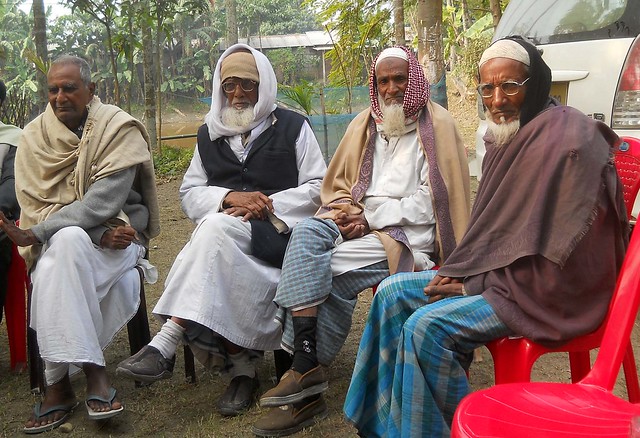Victims of 1950 riot at various areas of Barpeta district of Assam share their experience.
By TwoCircles.net Staff Reporter,
Guwahati: Even at the ripe age of 98 years, Kalimuddin has been living his life with a ‘scar’ which will never be erased. A farmer at Bogulamari village in Barpeta district in Assam along with several hundred others could not forget the horror of a fateful Saturday in 1950.
He is a witness, rather a victim of the riot which took place in several places in lower Assam. “It was a terrible moment for all of us. Thank God that we are still alive. How can we forget that episode,” said Kalimuddin, who was bit surprised when this correspondent wished to know about that incident.

Riot victim 98 year old Kalimuddin (2nd from right), Narendra Nath Sarkar (extreme left) and others in their village.
Now, he along with the neighbouring people who have seen the ghastly face of brutality of the riot do not want of such repetition at any cost. However, they express grief that no proper documentation was made of that incident which has definitely changed the fate of many forever.
He was a class VIII student of Langa Keramatia Madrassa in their neighbourhood when around 500 people from their area fled to East Pakistan (now Bangladesh) to get rid of the rage of the rioters through river route.
“It was just another beautiful morning till we heard the hue and cry of people and saw a mob in all white dress chasing the villagers. We saw some of our neighbours being butchered. All of us ran towards the river Beki (a tributary of river Brahmaputra). We stayed there on the bank for a couple of nights before leaving for East Pakistan on boats,” recalled Kalimuddin.
He even remembered of seeing the body of one Ibrahim Ali, one of the elders of the village, lying on the street when they were running for their lives. “What what could we do?” he added.
They reached Tangail district of present Bangladesh after travelling 18 days where they were provided food and shelter by the locals initially. But later they had to work for Rs 0.05 in a day or so.
This way a section of people stayed there for almost one and half years, meanwhile another section immediately made their way back to their native land. “This is where the problem started as these people who returned after almost more than a year were not included in the NRC (National Register of Citizen) later, although they were born and brought up in here only,” said Jaynuddin, a local of Bogulamari area who has also seen the riot.
However, in such a hostile environment there were always hope of harmony. These people who were Muslims were targeted by an anti-social elements in the area were found a place of peace in their Hindu Bengali neighbours.
“We are grateful to our neighbours like Narendra Nath Sarkar who and his family members took care of the cattle and our properties. There were many like them who really helped us in saving our lives from the miscreants. That is why we could come back and get our properties back. We take pride in our relationship. No outside enemy can damage it,” said Jaynuddin adding that altogether around 500 people were killed during the riot.
Sarkar also repents at the incident. “It was very unfortunate. We could do nothing much but saw them flee. Our hearts cried seeing their plight. We have always wanted to stay together peacefully but sections of anti-social elements create trouble,” Sarkar said.
Many like Kalimuddin and Jaynuddin could not even continue their studies even after their return to their place of birth.
After struggling for decades to survive, these unfortunate people have another major hurdle in their path in the form of natural calamities. The population which comprises of farmers are facing tough time with the ever increasing river erosion. Most of them have even given up doing jute and other corps due to this problem.
There are many who have become daily wage earners losing all their agriculture lands to the river.
